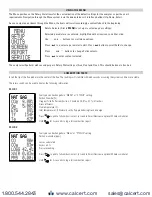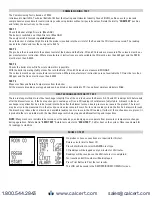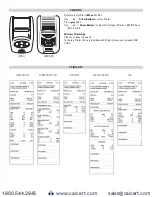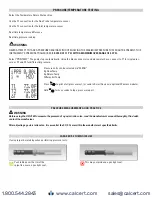
25
OTHER IMPORTANT FACTORS RELATING TO COMBUSTION
The three T’s of combustion
•
Time:
Amount of time that the fuel and oxygen are together in the combustion chamber
•
Temperature:
How high the temperature is determines the rate of oxidation, or spread of combustion
•
Turbulence:
How well the fuel and air are mixed
These three factors are all interrelated and will move your results along the combustion curves.
COMBUSTION MEASUREMENT TERMS
Other parameters measured include Net temperature, draft and efficiency.
Net Temperature
Net temperature is the difference between the combustion air entering the combustion chamber and the flue gas temperature past
the heat exchange. This is used to determine how efficient the system is extracting heat from the combustion process in addition to
the performance of the combustion process. On sealed systems that have ducted inlet air for combustion air, the Net temperature
must compare this air stream temperature with the flue gases. If the appliance simply uses room air for the combustion air, our
analyzers have an internal temperature sensor in the handset, so it will use this temperature when calculating Net temperature. The
most accurate results for efficiency are obtained when measuring flue gases at the point where flue temperature (not flame
temperature) is the highest.
Draft
Draft is the difference between the ambient pressure level and the pressure level in the flue.
This is created either by the natural buoyancy of the hot gases created in combustion lifting, or by an inducer fan that assists the flow
of flue gases up the stack. Most combustion equipment will specify the amount of draft that is required for proper operation. Draft
helps draw combustion air into the combustion chamber, and also helps in mixing the fuel and oxygen. Without proper draft, the
combustion process can spill poisonous by-products into the space where the appliance is located. This can be a risk to those in the
area, or create a danger to residents or employees working near the combustion equipment.
Efficiency
Efficiency is a measure of how well the fuel is burned to create heat, and how well the generated heat is captured for the intended
use. The information used to create this value are based on the fuels heating value, the heat lost up the flue and the gas components
in the flue gas. The original method to determine efficiency included many manual methods and lookup charts. As an example you
would measure the CO
2
level and the stack temperature and then reference a slide scale that would give you the relative efficiency
number. UEi’s electronic combustion analyzers perform the measurements on a continuous basis, and can calculate the efficiency as
adjustments are being made. Combine this with a printout and you are able to provide a before and after comparison of the combus-
tion equipment in relatively little time as part of normal servicing.
Combustion efficiency is not the same as AFUE (annual fuel usage
efficiency). AFUE is not measurable with any portable flue gas analyzer.
Combustion Efficiency Calculations
This identifies three sources of loss associated with fuel burning:
• Losses due to flue gases:
Dry Flue gas loss, moisture and hydrogen,
Sensible heat of water vapor, Unburned gas
• Losses due to refuse:
Combustible in ash, riddling and dust
• Other losses:
Radiation, convection, conduction other unmeasured losses
Net efficiency calculations assume that the energy contained in the water vapor (formed as a product of combustion and from wet
fuel) is recovered and the wet loss term is zero. Gross efficiency calculations assume that the energy contained in the water vapor
is not recovered. Since the fuel air mixture is never consistent there is the possibility of unburned/partially unburned fuel passing
through the flue. This is represented by the unburned carbon loss. Losses due to combustible matter in ashes, riddling, dust and grit,
radiation, convection and conduction are not included.
CO Air Free
Certain standards (ANSI Z21.1) for Carbon Monoxide are stated in terms of air-free. Air-free refers to the concentration of CO in
combustion gases undiluted with flue, or other gases containing little CO. This value is computed using an equation that takes into
account the O
2
concentration of the flue gas.
• If 5% O
2
is measured (O
2
m) in the flue then the CO gas value will be recalculated as if 0% were measured. The equation for
air-free is as follows:: COaf = CO PPM x [(20.9) / (20.9 - O
2
m)]
• In our example if a reading of 325 PPM were measured then the air-free value would be calculated as follows:
COaf = 325 PPM x [(20.9) / (20.9 - 5)] COaf = 325 PPM x [(20.9) / (15.9)] COaf = 427
We may be given a limit on our gas range by the local authority, which stated that we must not emit more than 400-PPM Carbon
Monoxide air-free. In the example we would be breaking the limit and corrective action should be taken to reduce the level of CO.
Air-free values prevent false readings being submitted, e.g. allowing more air into the boiler will increase the oxygen level in the flue
and dilute any toxic gas reading. Air-free referencing gives readings as if they were undiluted.
www.calcert.com
sales@calcert.com
1.800.544.2843
0
5
10
15
20
25
30


































